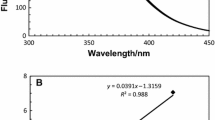Abstract
α-Lactalbumin (α-La) undergoes considerable structural changes upon loss of bound Ca2+ at acidic pH, leaving α-La in a molten globule structure. Using fluorescence the present work provides more insight into the structural transition of α-La at acidic pH leading to protein aggregation, most likely caused by a combination of hydrophobic and electrostatic interactions. The rate of aggregation is determined by the protein concentration and temperature applied. Availability of Ca2+ stabilises the protein, and thus prevent aggregation at pH values as low as pH 2.9. In contrast, presence of Cu2+ induces a destabilisation of the protein, which can be explained by a binding to the Zn2+ binding site in α-La, possibly resulting in structural alterations of the protein. In general, presence of anions destabilise α-La at pH values below pI, with SO4 2− exhibiting the strongest effect on the protein stability, thus correlating well with the Hofmeister series. At more acidic pH values far from pI, α-La becomes more stable towards ion induced aggregation, since higher ion activity is required to efficiently screen the charges on the protein surface. The results presented in this paper provide detailed knowledge on the external parameters leading to aggregation of α-La at acidic pH, thus permitting rational design of the aggregation process.








Similar content being viewed by others
References
de Wit JN (1989) The use of whey protein products. In: Developments on dairy chemistry, Elsevier Applied Science, London, pp 323–345
Barbut S (1995) Effect of sodium level on the microstructure and texture of whey protein isolate gels. Food Res Int 28(5):437–443
Lowe LL, Foegeding EA, Daubert CR (2003) Rheological proporties of fine-stranded whey protein isolate gels. Food Hydrocol 17:515–522
Rojas SA et al (1997) Gelation of commercial fractions of beta-lactoglobulin and alpha-lactalbumin. Int Dairy J 7(1):79–85
Schokker EP, Singh H, Creamer LK (2000) Heat-induced aggregation of β-lactoglobulin A and B with α-lactalbumin. Int Dairy J 10:843–853
Shimada K, Cheftel JC (1988) Texture characteristics, protein solubility, and sulfhydryl group/disulfide bond contents of heat-induced gels of whey protein isolate. J Agric Food Chem 36:1018–1025
Permyakov EA, Berliner LJ (2000) alpha-Lactalbumin: structure and function. FEBS Lett 473(3):269–274
Hill RL, Brew K (1975) Lactose synthease. In: Meister A (ed) Advances in enzymology, Wiley, pp 411–484
Dolgikh DA et al (1981) Alpha-Lactalbumin: compact state with fluctuating tertiary structure? FEBS Lett 136(2):311–315
Kuwajima K (1996) The molten globule state of α-Lactalbumin. FASEB J 10:102–109
Pfeil W (1998) Protein stability and folding. A collection of thermodynamic data. Springer, Berlin Heidelberg New York
Håkansson A et al (1995) Apoptosis induced by a human milk protein. Proc Natl Acad Sci USA 92:8064–8068
Svensson M et al (1999) Molecular characterisation of α-Lactalbumin folding variants that induce apoptosis in tumor cells. J Biol Chem 274(10):6388–6396
Clarke J, Fersht AR (1993) Engineered disulfide bonds as probes of the folding pathway of barnase: Increasing the stability of proteins against the rate of denaturation. Biochemistry 32:4322–4329
Lakowicz JR (1999) Principles of fluorescence spectroscopy, 2nd ed. Kluwer/Plenum Publisher
Ipsen R, Otte J, Qvist KB (2001) Molecular self-assembly of partially hydrolysed alpha-lactalbumin resulting in strong gels with a novel microstructure. J Dairy Res 68(2):277–286
Petersen MTN, Fojan P, Pedersen S (2001) How do lipases and esterases work: The electrostatic contribution. J Biotechnol 85:115–147
Permyakov EA, Morozova LA, Burstein EA (1985) Cation binding effects on the pH, thermal and urea denaturation transitions in alpha-lactalbumin. Biophys Chem 21(1):21–31
Permyakov EA et al (1981) Calcium-binding to alpha-lactalbumin – structural rearrangement and association constant evaluation by means of intrinsic protein fluorescence changes. Biochem Biophys Res Commun 100(1):191–197
Creighton TE (1993) Proteins, structure and molecular properties, 2nd ed. W.H. Freshman and Company
Tieghem E, Van Dael H, Van Cauwelaert F (1991) A circular dichroic study of Cu(II) binding to bovine α-Lactalbumin. J Inorg Biochem 42:119–131
Van Dael H et al (1992) Conformational aspects of the Cu2+ binding to α-lactalbumin. Characterization and stability of the Cu-bound state. Biophys Chem 42:235–242
Goers J et al (2002) Conformational prerequisites for alpha-lactalbumin fibrillation. Biochemistry 41(41):12546–12551
Doi E (1993) Gels and gelling of globular proteins. Trends Food Sci Technol 4:1–5
McClements D, Keogh M (1995) Physical properties of cold-setting gels formed from heat -denatured whey protein isolate. J Sci Food Agric 69:7–14
Bryant CM, McClements DJ (1998) Molecular basis of protein functionality with special consideration of cold-set gels derived from heat-denatured whey. Trends Food Sci Technol 9:143–151
Cawthern KM, Permyakov E, Berliner LJ (1996) Membrane-bound states of alpha-lactalbumin: Implications for protein stability and conformation. Protein Sci 5(7):1394–1405
Acknowledgements
Special thanks are regarded to John Sørensen, Hans Bertelsen and Kristian Albertsen from Arla Foods amba for the invaluable collaboration and constructive discussions. Furthermore, Poul Larsen from Aalborg University is acknowledged for his help in obtaining the confocal microscopy results.
Author information
Authors and Affiliations
Corresponding author
Rights and permissions
About this article
Cite this article
Pedersen, J.B., Fojan, P., Sorensen, J. et al. Towards Control of Aggregational Behaviour of α-Lactalbumin at Acidic pH. J Fluoresc 16, 611–621 (2006). https://doi.org/10.1007/s10895-006-0088-6
Received:
Accepted:
Published:
Issue Date:
DOI: https://doi.org/10.1007/s10895-006-0088-6




